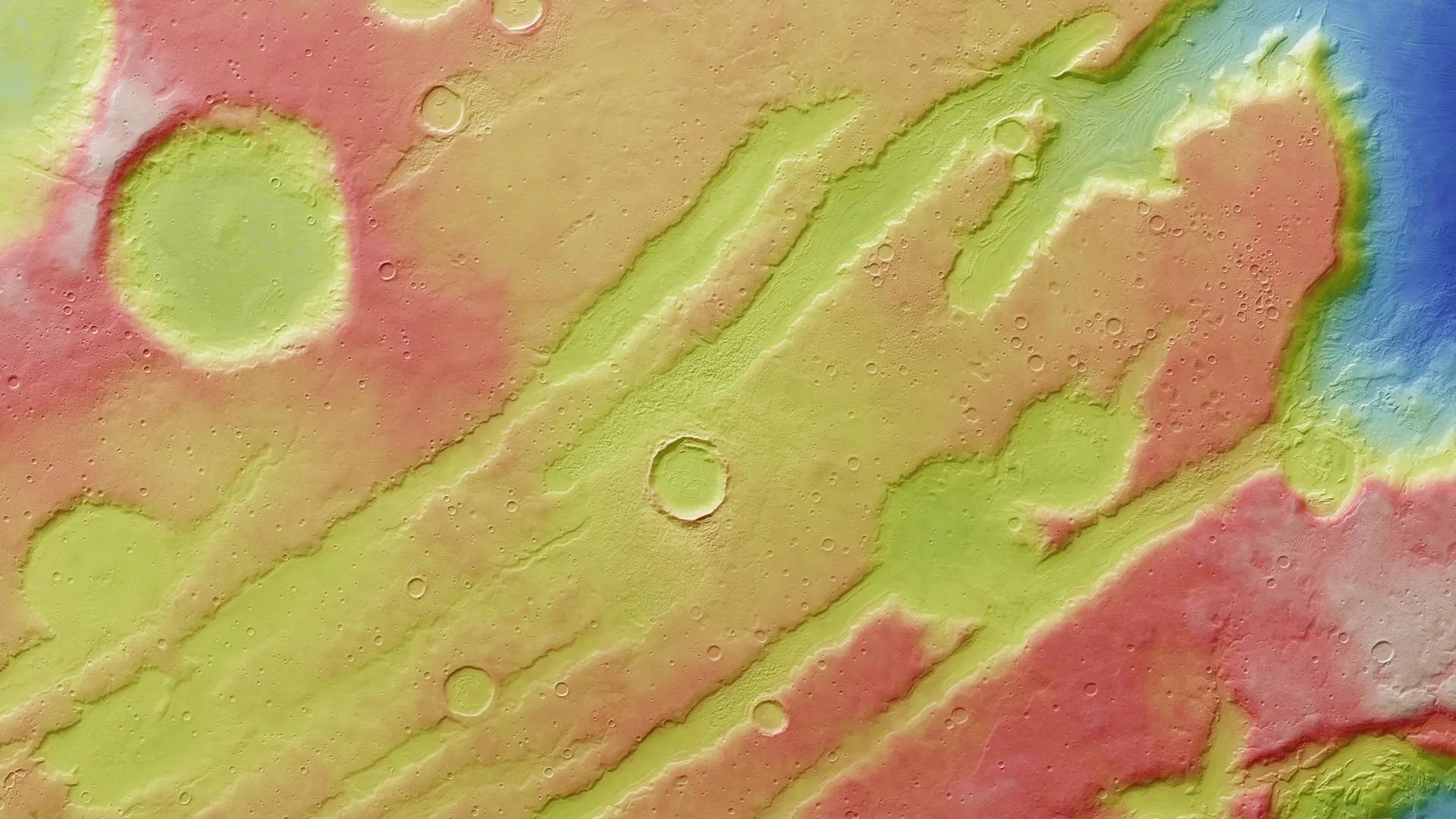New Mars images reveal hidden traces of a recent ice age
Frozen glacial scars across Mars expose dramatic climate cycles that once reshaped the planet.
- Date:
- November 26, 2025
- Source:
- European Space Agency (ESA)
- Summary:
- Mars’s Coloe Fossae reveals a landscape shaped by ancient ice ages, with deep valleys, cratered terrain, and frozen debris flows preserved from a time when the planet’s climate dramatically shifted.
- Share:

As we move from Mars's equatorial region toward its northern latitudes, we encounter Coloe Fossae. This area contains a series of long, shallow grooves set within a landscape of deep valleys, scattered impact craters, and surface textures that point to a distant ice age on the Red Planet.
Ice ages are not unique to Earth. Our planet alone has experienced several over the past 2.5 billion years. The most recent one, which reached its peak about 20,000 years ago, reduced Earth's global average temperature to approximately 7-10 °C (up to 8 °C cooler than today).
These ancient freezes are unrelated to modern human-driven climate warming. Instead, they result from slow, natural changes in a planet's orbit around the Sun and shifts in the angle of its rotational axis. During an ice age, glaciers and ice sheets expand, and varying temperatures cause these ice masses to repeatedly advance and shrink.
Martian Ice Age Clues Revealed in New Imagery
Other planets also record their own cycles of deep cold. Clear evidence appears on Mars, and the latest images from the High Resolution Stereo Camera aboard ESA's Mars Express show how strongly these past climates shaped the terrain.
In the images, several long, nearly parallel features run diagonally across the scene. These are the structures known as Coloe Fossae, created when alternating blocks of surface material dropped downward. The region also holds numerous craters formed by incoming space debris. They vary widely in shape and age: some are crisp, some eroded, some overlapping, and others partly buried. On the floors of many valleys and craters, swirling, grooved patterns reveal where icy material once moved during an earlier martian ice age.
Glacial Flow Patterns Across Mars
These distinctive textures offer insight into Mars's former climate. Scientists describe them as lineated valley fill (found in valleys) or concentric crater fill (seen in craters). They formed when slow-moving mixtures of ice and debris traveled across the surface, similar to the behavior of glaciers on Earth, and eventually became covered by a thicker layer of rocky material.
This region lies at a latitude of 39°N, far from Mars's north pole (at 90°N). This raises an important question: how did so much ice end up here?
How Mars Gathered Ice Far From Its Poles
The explanation comes from the repeated advance and retreat of glaciers during a previous martian ice age. Although modern Mars is dry, its long-term climate has swung between warmer and colder phases, with cycles of freezing and melting driven mainly by changes in the planet's axial tilt.
During colder intervals, ice spread outward from the poles and reached into the mid-latitudes. When temperatures rose again, the ice retreated but left behind clear traces of its presence. Lineated valley fill and concentric crater fill appear throughout this entire latitude zone, suggesting that Mars once experienced a global climate shift. This particular area may have been blanketed by ice as recently as half a million years ago, marking the end of the planet's most recent ice age.
Mapping Mars's Ancient Glacial Landscape
These indicators of past glacial activity, along with Coloe Fossae and the surrounding craters, are visible in the annotated images. The separation between Mars's northern and southern terrains is especially prominent in topographic and context maps. This boundary circles the planet; in some locations it forms a sharp, two-km-high scarp, while in others, such as here, it appears as a wide and heavily eroded transition zone (known as Protonilus Mensae).
Features such as lineated valley fill and concentric crater fill were also noted in our August Mars Express report on Acheron Fossae.
How the Images Were Created
The Mars Express High Resolution Stereo Camera (HRSC) was developed and is operated by the German Aerospace Center (Deutsches Zentrum für Luft- und Raumfahrt; DLR). Processing of the camera's data was carried out at the DLR Institute of Planetary Research in Berlin-Adlershof. The working group of Planetary Science and Remote Sensing at Freie Universität Berlin produced the final image products shown here.
Story Source:
Materials provided by European Space Agency (ESA). Note: Content may be edited for style and length.
Cite This Page: